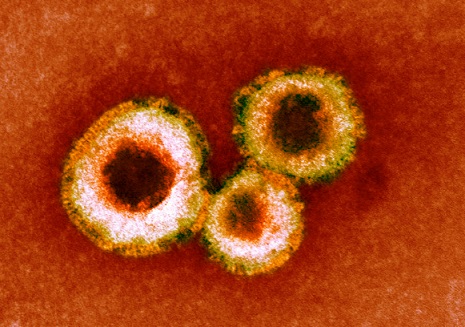Israeli Study Finds That Human Metapneumovirus Uses Unique Strategy to Escape Recognition by NK cells
Nikhil Prasad Fact checked by:Thailand Medical News Team Dec 31, 2024 11 months, 2 weeks, 4 days, 21 hours, 36 minutes ago
HMPV News: Introduction to Human Metapneumovirus and Natural Killer Cells
Human metapneumovirus (HMPV), first identified in 2001, is a respiratory virus affecting nearly all children by the age of five. It often causes flu-like symptoms but can lead to severe respiratory infections, particularly in young children, the elderly, and immunocompromised individuals. Despite its prevalence, much remains unknown about the interactions between HMPV and the immune system, especially with natural killer (NK) cells, a critical component of the innate immune response.
 Israeli Study Finds That Human Metapneumovirus Uses Unique Strategy to Escape
Israeli Study Finds That Human Metapneumovirus Uses Unique Strategy to Escape
Recognition by NK cells
NK cells play a vital role in identifying and eliminating infected cells. They rely on receptors like NKG2D to detect stress-induced ligands expressed on the surface of virus-infected cells. In this
HMPV News report, we discuss how HMPV cleverly evades immune detection by NK cells through the downregulation of these stress-induced ligands.
A Closer Look at the Study and Its Findings
Researchers from the Lautenberg Center for Immunology and Cancer Research at Hebrew University Hadassah Medical School and Tel Aviv University conducted an in-depth study on the mechanisms HMPV uses to avoid NK cell-mediated destruction. The findings of this study reveal a novel immune evasion strategy employed by the virus, which could pave the way for new treatment avenues.
Using cell cultures, the researchers demonstrated that HMPV infection led to a significant decrease in the expression of key ligands for the NKG2D receptor. These ligands - MICA, MICB, ULBP2, and ULBP3 - are typically upregulated during cellular stress to signal immune cells. However, HMPV infection triggers their downregulation, effectively "hiding" infected cells from NK cell recognition.
Interestingly, the study found that the viral proteins G and M2.2 play distinct roles in this process. The G protein was specifically implicated in the downregulation of ULBP2 via lysosomal degradation. Meanwhile, M2.2 was found to target MICA and MICB for reduced surface expression.
The Implications of Ligand Downregulation
This downregulation has profound implications for how the immune system responds to HMPV. By reducing the surface expression of these ligands, HMPV minimizes the likelihood of NK cell activation and subsequent destruction of infected cells. The study employed assays that measured NK cell activity, such as the CD107a degranulation assay, to confirm this immune evasion tactic.
Moreover, while mRNA levels of these ligands increased following infection - a natural cellular response to stress - their surface expression was suppressed. This suggests that HMPV employs sophisticated mechanisms to counteract cellular defenses, ensuring its survival and replication.
Unraveling the Role of Specific Viral Proteins
The researchers explore
d how individual HMPV proteins contribute to immune evasion. By expressing each viral protein in isolation, they identified M2.2 and G as critical players in ligand downregulation. The G protein specifically targeted ULBP2 for degradation in the lysosomes, a cellular recycling system. In contrast, M2.2 alone was sufficient to suppress the expression of MICA and MICB.
These findings highlight the complexity of HMPV’s interactions with the immune system and underscore the importance of further research to understand these processes fully.
Potential for Future Treatments and Vaccines
Understanding how HMPV evades immune detection opens up new possibilities for therapeutic interventions. Targeting the viral proteins responsible for ligand downregulation could enhance the immune system's ability to detect and destroy infected cells. Additionally, this knowledge could inform the development of vaccines that bolster immune defenses against HMPV.
Currently, no specific vaccines or antiviral treatments exist for HMPV, making these findings particularly valuable. As researchers continue to unravel the virus's strategies, they bring us closer to effective solutions for combating this pervasive pathogen.
Conclusions and Broader Implications
This study sheds light on the intricate mechanisms HMPV uses to escape immune surveillance. By downregulating stress-induced ligands for the NKG2D receptor, the virus effectively evades NK cell detection, ensuring its survival and propagation. The discovery of the roles played by the G and M2.2 proteins in this process is a significant step forward in understanding HMPV pathogenesis.
The broader implications of this research extend to other viruses employing similar immune evasion tactics. By identifying common strategies, scientists can develop cross-viral treatments and interventions, enhancing global health security.
As we continue to confront emerging and re-emerging infectious diseases, studies like this one underscore the importance of understanding pathogen-host interactions at the molecular level. By illuminating the tactics viruses use to subvert immune responses, we can better prepare to defend against them.
The study findings were published in the peer-reviewed journal: Viruses.
https://www.mdpi.com/1999-4915/12/7/781
For the latest
HMPV News, keep on logging to Thailand Medical News.
Read Also:
https://www.thailandmedical.news/news/louisiana-study-finds-that-human-metapneumovirus-uses-mirnas-to-impair-immune-responses-involving-interferons
https://www.thailandmedical.news/news/human-metapneumovirus-infections-on-the-rise-in-china
